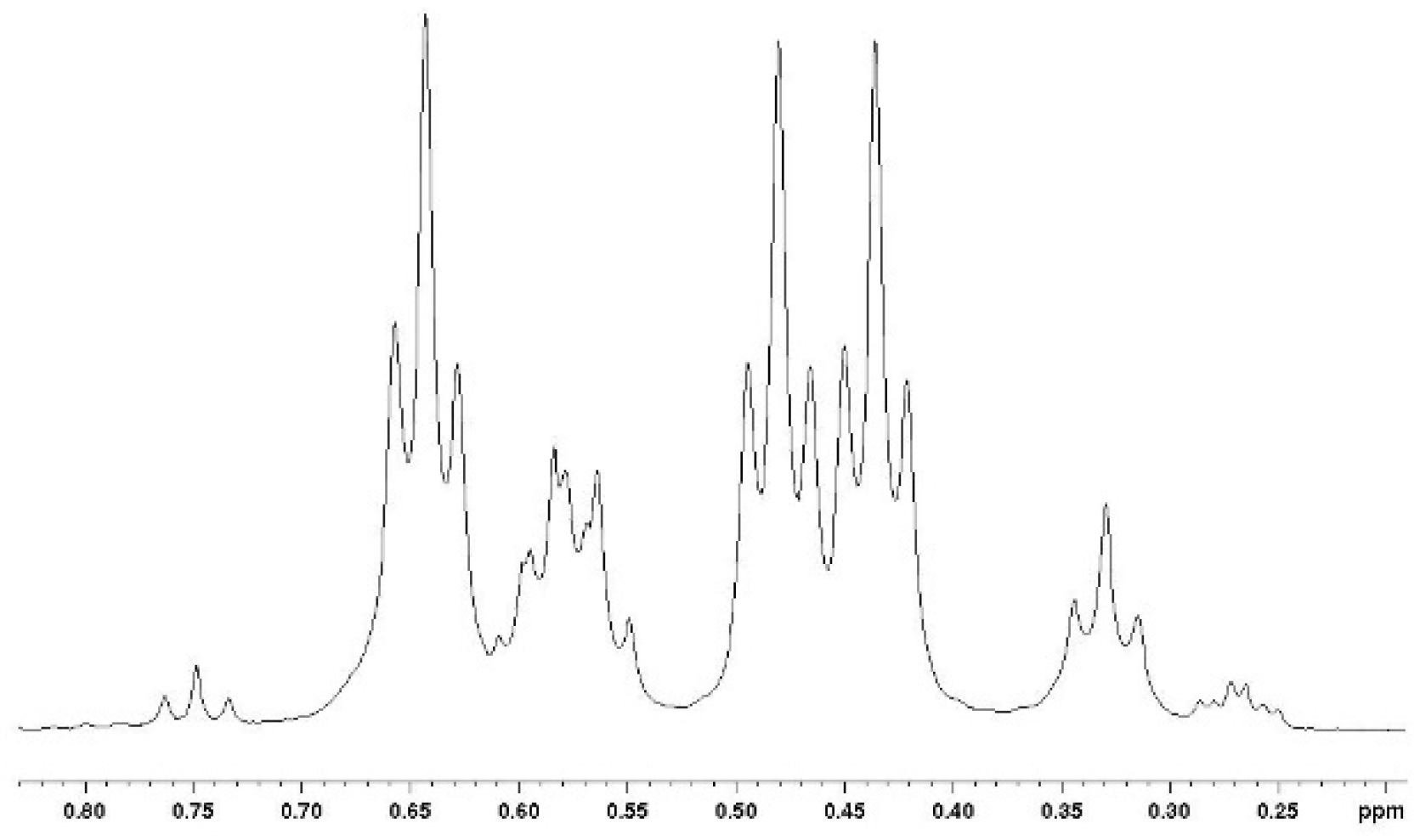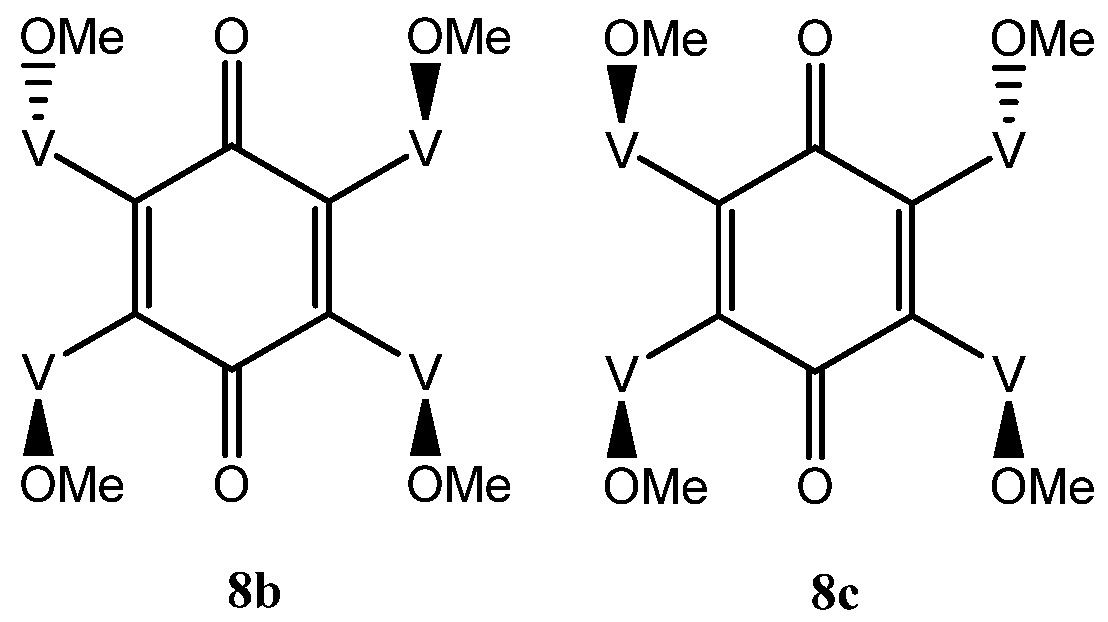Addition of Vindoline to p-Benzoquinone: Regiochemistry, Stereochemistry and Symmetry Considerations
Abstract
:1. Introduction
2. Results
2.1. Preparation of the Mono-Adduct 3 of Vindoline and Benzoquinone
2.2. Preparation of Higher Stoichiometry Adducts
2.2.1. The Bis Adducts. The Simple Adducts and General Considerations
2.2.2. The Vicinal Bis Adduct 6
2.2.3. Vicinal Bis Adducts and Symmetry Considerations
2.2.4. The Vicinal Adducts and NMR Assignments
2.2.5. Higher Order Adducts
2.2.6. The NOESY Experiment: Further Complexity and DFT Calculations
3. Discussion
4. Biological Evaluation of the Compounds
5. Materials and Methods
5.1. General
5.2. Preparation of 2-(10-Vindolinyl)-benzoquinone 3
5.3. Preparation of 2,5-di-(10-Vindolinyl)-benzoquinone 4, of 2,6-di-(10-Vindolinyl)-benzoquinone 5 and of 2,3-di-(10-Vindolinyl)-benzoquinone 6
5.4. Preparation of 2,3,5-tris-(10-Vindolinyl)-benzoquinone 7 and of 2,3,5,6-tetra-(10-Vindolinyl)-benzoquinone 8
5.5. Computational Details
Supplementary Materials
Author Contributions
Funding
Institutional Review Board Statement
Informed Consent Statement
Data Availability Statement
Acknowledgments
Conflicts of Interest
Appendix A



Appendix B
References
- Gorman, M.; Neuss, N.; Biemann, K. Vinca alkaloids. X. The structure of vindoline. J. Am. Chem. Soc. 1962, 84, 1058–1059. [Google Scholar] [CrossRef]
- Passarella, D.; Giardini, A.; Peretto, B.; Fontana, G.; Sacchetti, A.; Silvani, A.; Ronchi, C.; Cappelletti, G.; Cartelli, D.; Borlake, J.; et al. Inhibitors of tubulin polymerization: Synthesis and biological evaluation of hybrids of vindoline, anhydrovinblastine and vinorelbine with thiocolchicine, podophyllotoxin and baccatin III. Bioorg. Med. Chem. 2008, 16, 6269–6285. [Google Scholar] [CrossRef]
- Keglevich, A.; Dányi, L.; Rieder, A.; Horváth, D.; Szigetvári, A.; Dékány, M.; Szántay, C., Jr.; Dhahir Latif, A.; Hunyadi, A.; Zupkó, I.; et al. Synthesis and Cytotoxic Activity of New Vindoline Derivatives Coupled to Natural and Synthetic Pharmacophores. Molecules 2020, 25, 1010. [Google Scholar] [CrossRef] [PubMed] [Green Version]
- Harley-Mason, J. Total synthesis of (±)-16-hydroxydihydrocleavamines and partial synthesis of demethoxycarbonyldeoxyvinblastine. J. Chem. Soc. Chem. Commun. 1967, 20, 1048–1049. [Google Scholar] [CrossRef]
- Atta-ur-Rahman. Partial synthesis of D-15, 20-anhydrovinblastine. Pak. J. Sci. Ind. Res. 1971, 14, 487–488. [Google Scholar]
- Potier, P.; Langlois, N.; Langlois, Y.; Guéritte, F. Partial synthesis of vinblastine-type alkaloids. J. Chem. Soc. Chem. Commun. 1975, 16, 670–671. [Google Scholar] [CrossRef]
- El-Sayed, A.; Handy, G.A.; Cordell, G.A. Catharanthus alkaloids. Confirming structural evidences and antineoplastic activity of the bisindole alkaloids leurosine N-oxide, roseadine and vindolicine from Catharanthus roseus. J. Nat. Prod. 1983, 46, 517–527. [Google Scholar] [CrossRef] [PubMed]
- Tiong, S.H.; Looi, C.Y.; Arya, A.; Wong, F.W.; Hazni, H.; Mustafa, M.R.; Awang, K. Vindogentianine, a hypoglycemic alkaloid from Catharanthus roseus (L) G. Don (Apocynaceae). Fitoterapia 2015, 102, 182–188. [Google Scholar] [CrossRef] [PubMed]
- Ali, I.; Chaudhary, M.I. Bannucine, a new dihydroindole from Catharanthus roseus (L) G. Don. J. Chem. Soc. Perkin Trans. 1986, 1, 923–926. [Google Scholar] [CrossRef]
- Morrison, M.; Steele, W.; Danner, D. The Reaction of Benzoquinone with Amines and Proteins. Arch. Biochem. Biophys. 1969, 134, 515–523. [Google Scholar] [CrossRef]
- Katritzky, A.R.; Fedoseyenko, D.; Mohapatra, P.P.; Steel, P.J. Reactions of p-Benzoquinone with S-Nucleophiles. Synthesis 2008, 5, 778–785. [Google Scholar] [CrossRef]
- Jiang, J.-H.; Boominathan, S.S.K.; Hu, W.-P.; Chen, C.-H.; Vandavasi, J.K.; Lin, Y.-T.; Wang, J.-J. Sequential, one-pot access to arylated benzoquinones/naphtoquinones from phenols/naphtols. Eur. J. Org. Chem. 2016, 2016, 2284–2289. [Google Scholar] [CrossRef]
- Zhang, H.-B.; Liu, L.; Chen, Y.-J.; Wang, D.; Li, C.-J. Synthesis of aryl-substituted 1,4-benzoquinone via water-promoted and In(OTf)3-catalyzed in situ conjugate addition-dehydrogenation of aromatic compounds to 1,4-benzoquinone in water. Adv. Synth. Catal. 2006, 348, 229–235. [Google Scholar] [CrossRef]
- Jonasson, C.; Karstens, W.F.J.; Hiemstra, H.; Bäckvall, J.E. A Palladium(II)-catalyzed intramolecular 1,2-oxidation of allenes involving nitrogen nucleophiles. Tetrahedron Lett. 2000, 41, 1619–1622. [Google Scholar] [CrossRef]
- Escolastico, C.; Santa Maria, M.D.; Claramunt, R.M.; Jimeno, M.L.; Alkorta, I.; Foces-Foces, C.; Cano, F.H.; Elguero, J. Imidazole and benzimidazole addition to quinones. Formation of meso and d,l isomers and crystal structure of the d,l isomer of 2,3-bis(benzimidazol-l’-yl)-1,4-dihydroxybenzene. Tetrahedron 1994, 50, 12489–12510. [Google Scholar] [CrossRef]
- Barone, V.; Cossi, M. Quantum calculation of molecular energies and energy gradients in solution by a conductor solvent model. J. Phys. Chem. A 1998, 102, 1995–2001. [Google Scholar] [CrossRef]
- Cossi, M.; Rega, N.; Scalmani, G.; Barone, V. Energies, structures, and electronic properties of molecules in solution with the C-PCM solvation model. J. Comput. Chem. 2003, 24, 669–681. [Google Scholar] [CrossRef] [PubMed]
- Zhao, Y.; Truhlar, D.G. The M06 suite of density functionals for main group thermochemistry, thermochemical kinetics, noncovalent interactions, excited states, and transition elements: Two new functionals and systematic testing of four M06-class functionals and 12 other functionals. Theor. Chem. Acc. 2008, 120, 215–241. [Google Scholar] [CrossRef] [Green Version]
- Frisch, M.J.; Trucks, G.W.; Schlegel, H.B.; Scuseria, G.E.; Robb, M.A.; Cheeseman, J.R.; Scalmani, G.; Barone, V.; Petersson, G.A.; Nakatsuji, H.; et al. Gaussian 16, Revision B.0; Gaussian, Inc.: Wallingford, CT, USA, 2016. [Google Scholar]
- Canneaux, S.; Bohr, F.; Henon, E. KiSThelP: A Program to Predict Thermodynamic Properties and Rate Constants from Quantum Chemistry Results. J. Comput. Chem. 2014, 35, 82–93. [Google Scholar] [CrossRef] [PubMed]
- Wenkert, E.; Cochran, D.W.; Hagaman, E.W.; Schell, F.M.; Neuss, N.; Katner, A.S.; Potier, P.; Kan, C.; Plat, M.; Koch, M.; et al. Carbon-13 nuclear magnetic resonance spectroscopy of naturally occurring substances. XIX. Aspidosperma alkaloids. J. Am. Chem. Soc. 1973, 95, 4990–4995. [Google Scholar] [CrossRef] [PubMed]













| Entry | 1 | 2 | Yield (%) | |||||
|---|---|---|---|---|---|---|---|---|
| Mole Ratio | 3 | 4 | 5 | 6 | 7 | 8 | ||
| 1 | 1 | 1 | NR | |||||
| 2 | 1 | 1 | NR | |||||
| 3 | 1 | 1 | 48 | 3 | 16 | |||
| 4 | 1 | 1 | 24 | 2 | 20 | |||
| 5 | 2 | 1 | 14 | 2 | 15 | |||
| 6 | 1 | 1 | 38 | 4 | 36 | |||
| 7 | 1 | 2 | 71 | 2 | 20 | |||
| 8 | 1 | 4 | 95 | 3 | ||||
| 9 | 2 | 1 | 16 | 4 | 40 | |||
| 10 | 2 | 1 | 12 | 5 | 59 | 5 | ||
| 11 | 2 | 1 | 23 | 5.5 | 32 | 4 | traces | |
| 12 | 2.4 | 1 | traces | 8 | 75 | 7 | ||
| 13 | 3 | 1 | 2 | 34 | traces | 31 | 4 | |
| 14 | 4 | 1 | 5 | 37 | 15 | |||
| Test | HeLa | Au 565 | 3T3 | ||||||
|---|---|---|---|---|---|---|---|---|---|
| Compounds | Conc. | % Inhibition | IC50 ± SD | Conc. | % Inhibition | IC50 ± SD | Conc. (µM) | % Inhibition | IC50 ± SD |
| (µM) | (µM) | (µM) | (µM) | (µM) | |||||
| 3 | 30 | 10.1 | Inactive | 50 | Inactive | 50 | 40.2 | Inactive | |
| 4 | 30 | 96.2 | 12 ± 2 | 50 | 98.39 | 6 ± 0.2 | 50 | 93.9 | 4 ± 0 |
| 5 | 30 | 99.2 | 4 ± 0.6 | 50 | 98.83 | 2 ± 0.2 | 50 | 99.6 | 6 ± 0.2 |
| 7 | 30 | 86.14 | 14 ± 2 | 50 | 85.73 | 7 ± 1 | 50 | 84.0 | 21 ± 1 |
| Doxorubicin | 30 | 89.1 | 1.3 ± 04 | 50 | 98.77 | 0.085 ± 0.03 | - | - | - |
| Cycloheximide | - | - | - | - | - | - | - | - | 0.26 ± 0.1 |
Publisher’s Note: MDPI stays neutral with regard to jurisdictional claims in published maps and institutional affiliations. |
© 2021 by the authors. Licensee MDPI, Basel, Switzerland. This article is an open access article distributed under the terms and conditions of the Creative Commons Attribution (CC BY) license (https://creativecommons.org/licenses/by/4.0/).
Share and Cite
Ali, S.; Hénon, E.; Leroy, R.; Massiot, G. Addition of Vindoline to p-Benzoquinone: Regiochemistry, Stereochemistry and Symmetry Considerations. Molecules 2021, 26, 6395. https://doi.org/10.3390/molecules26216395
Ali S, Hénon E, Leroy R, Massiot G. Addition of Vindoline to p-Benzoquinone: Regiochemistry, Stereochemistry and Symmetry Considerations. Molecules. 2021; 26(21):6395. https://doi.org/10.3390/molecules26216395
Chicago/Turabian StyleAli, Shamsher, Eric Hénon, Ritchy Leroy, and Georges Massiot. 2021. "Addition of Vindoline to p-Benzoquinone: Regiochemistry, Stereochemistry and Symmetry Considerations" Molecules 26, no. 21: 6395. https://doi.org/10.3390/molecules26216395
APA StyleAli, S., Hénon, E., Leroy, R., & Massiot, G. (2021). Addition of Vindoline to p-Benzoquinone: Regiochemistry, Stereochemistry and Symmetry Considerations. Molecules, 26(21), 6395. https://doi.org/10.3390/molecules26216395






